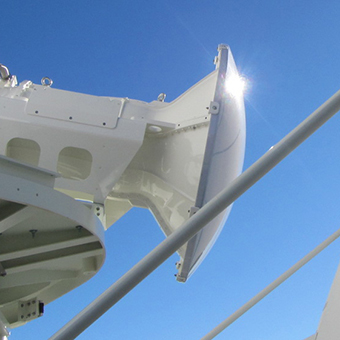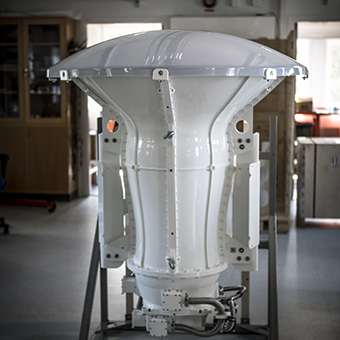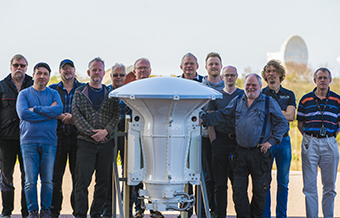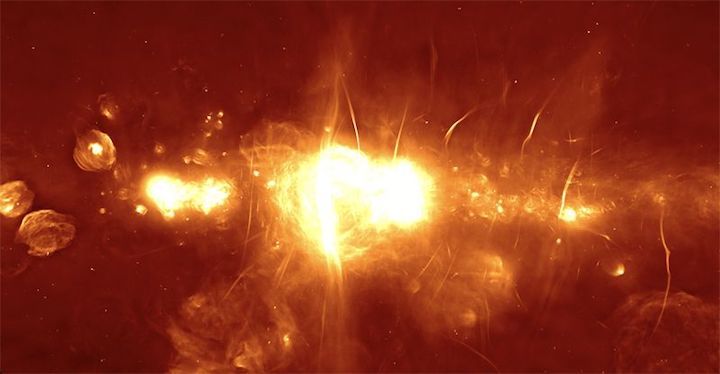Onsala Space Observatory has delivered its largest technology contribution to the SKA (Square Kilometre Array) project. A metre (3 ft) across, the 180 kg (400 lb) instrument is the first in place of over a hundred to be mounted on dish antennas in the Karoo Desert, today home to the 64-dish-strong new MeerKAT telescope.
The Band 1 receiver, as it is called, allows the dish to measure radio waves with a frequency between 0.35 and 1.05 Gigahertz (wavelength 30-85 cm).

The receiver is being tested on one of the 64 antennas in MeerKAT, one of today's largest radio telescopes and is in the same location in the Karoo desert where the SKA's antennas will be located. The instrument is a prototype manufactured in Sweden by Chalmers University of Technology in collaboration with Swedish industry, and it is designed to be mass-produced.
Sweden is one of 11 countries in the international SKA project, which will build the world's largest radio telescope at radio-quiet sites in Africa and Australia. The project is approaching the end of its design phase and construction is expected to start in the early 2020s.
As part of the SKA, Swedish receivers will participate in measurements of radio waves from many different sources in space. Scientists expect to make most sensitive radio measurements ever. They plan to test Einstein's theories to their limits and to explore the history of the universe by measuring millions of galaxies at distances of millions of light years.

"This is a proud moment for us, getting a first glimpse of what the world's biggest radio telescope will be like. We work with developing the world's best receiver technology and hope that our contribution to the telescope will make it possible for humanity to see things we have never seen before", says Miroslav Pantaleev, project manager for SKA at Onsala Space Observatory.
The receiver’s journey to Africa has been preceded by intensive collaboration between researchers and engineers at Onsala Space Observatory together with industrial partners, to ensure both performance and resilience. Before its trip, the instrument underwent tough environmental tests in Sweden, both in Onsala and at Saab Bofors Test Centre in Karlskoga.

John Conway, professor of observational radio astronomy at Chalmers and director of Onsala Space Observatory, looks forward beyond MeerKAT to the future dish array, SKA-mid.
"When the dishes in SKA-mid are operational, the world's astronomers will be able to access the world's most sensitive radio telescope and many exciting projects will be possible. We hope, among other things, to find new pulsars to test Einstein's theories, to study in detail how galaxies like the Milky Way were built during the history of the universe – and, of course, to make unexpected discoveries”, he says.
+++
High-resolution images are available at https://www.flickr.com/photos/onsala/albums/72157696496569481

1a (top). The Band 1 receiver has been installed on one of MeerKAT’s antennas. Out in the Karoo Desert in South Africa, 64 dishes today constitute the MeerKAT telescope. Later, these will be incorporated into the world's largest radio telescope, the SKA. On one of these antennas, Swedish technology is now being tested which will make the telescope the world’s most sensitive yet. In this image, the Swedish-built Band 1 receiver can be seen mounted underneath the dish's round white secondary mirror.
(Credit: SARAO)
1b. The Band 1 receiver’s protective cover reflects the desert Sun. To the right is the MeerKAT antenna’s secondary mirror.
(Credit: SARAO)
2. The Band 1 receiver captures a wide range of radio waves. A radio telescope with a dish antenna needs one or more feeds to guide radio waves with a wide range of frequencies up to the receiver equipment.
The Band 1 feed has a curved profile with four ridges on the inside. This Quadridge design was be adapted to SKA project requirements using mathematics, physics and optimisation algorithms, explains Jonas Flygare, PhD student at Chalmers.
“We determined the feed’s curved lines using algorithms that stochastically search for those shapes that best receive the radio waves, given our specifications. To find the optimum design you need to simulate a great number of different shapes of the antenna. The feed’s performance on the telescope has been evaluated together with EMSS Antennas in South Africa, and with a system simulator developed by Marianna Ivashina and colleagues at the Department of Electrical Engineering at Chalmers" says Jonas Flygare.
(Credit: Chalmers / Johan Bodell)

3. The engineers in the Band 1 project at Onsala Space Observatory. From left: Lars Wennerbäck, Miroslav Pantaleev, Jan Karaskuru, Per Björklund, Christer Hermansson, Leif Helldner, Bo Wästberg, Jonas Flygare, Lars Pettersson, Ronny Wingdén, Magnus Dahlgren and Ulf Kylenfall.
(Credit: Chalmers / Johan Bodell)
4. Vibration tests in Karlskoga. The receiver is subjected to tough vibration tests at Bofors Test Centre in Karlskoga. Video (10 sec) available.
Credit: Chalmers / Leif Helldner
5. Low noise amplifiers in the Band 1 feed for SKA. The Gothenburg company Low Noise Factory developed the unique low noise amplifiers (LNA) for SKA Band 1 that are visible in the middle of this image. They are specially designed for optimal performance without the need for cooling the feed.
(Credit: Chalmers / Johan Bodell)
More about the SKA project
The Square Kilometre Array (SKA) project is an international effort to build the world’s largest radio telescope, led by SKA Organisation. The SKA will conduct transformational science to improve our understanding of the Universe and the laws of fundamental physics, monitoring the sky in unprecedented detail and mapping it hundreds of times faster than any current facility.
The SKA is not a single telescope, but a collection of telescopes or instruments, called an array, to be spread over long distances. The SKA is to be constructed in two phases: Phase 1 (called SKA1) in South Africa and Australia; Phase 2 (called SKA2) expanding into other African countries, with the component in Australia also being expanded.
The SKA Organization is supported by 11 member countries - Australia, Canada, China, India, Italy, New Zealand, South Africa, Spain, Sweden, The Netherlands and the United Kingdom - and has brought together some of the world’s finest scientists, engineers and policy makers and more than 100 companies and research institutions across 20 countries in the design and development of the telescope.
Sweden is represented in the SKA Organisation by Onsala Space Observatory, Chalmers University of Technology. Onsala Space Observatory is Sweden’s national facility for radio astronomy. The observatory is hosted by the Department of Space, Earth and Environment at Chalmers University of Technology, and is operated on behalf of the Swedish Research Council.
SKA's Dish Consortium is responsible for the design and testing of the dish that will be SKA-mid, one of two instruments in SKA. Chalmers and Onsala Space Observatory represent the Sweden Consortium, led by China and consisting of engineers and researchers at research institutes and companies in France, Italy, Canada, China, Great Britain, Sweden, South Africa and Germany.
More about SKA is available at http://www.skatelescope.org
More about the Band 1 receiver and Swedish industry in the SKA project
The receiver has been developed to capture the longest radio waves for which SKA's dish antennas are sensitive. The frequency range is called Band 1 and extends between 350 and 1050 MHz (wavelength 30-85 cm).
The project was led by Onsala Space Observatory, Chalmers. The design and system design of the feed was performed by Onsala Space Observatory and funded by the Swedish Research Council.
In industrial liaison for the project Chalmers has worked together with Big Science Sweden and Vinnova.
Several companies from both Sweden and abroad have also contributed to the project. Leax Arkivator, Gothenburg, Sweden, was responsible for the mechanical design of the feed. The metal parts were manufactured at Ventana Group in Hackås, Sweden, and at MegaMeta, in Kaunas, Lithuania. South Africa’s EMSS has delivered control electronics. System engineering work was coordinated by EMSS Antennas in South Africa and the South African Radio Astronomy Observatory (SARAO). The receiver’s amplifiers are developed by Low Noise Factory in Gothenburg, and were built in the clean room of Chalmers Nanofabrication Laboratory in Gothenburg. Industrial partners for the SKA project also include Omnisys, Gothenburg, Sweden, who developed design concepts early in the project. The overall project work was managed by CSIRO (Australia), CETC54 (China) and the SKA Organisation project office (UK).
Quelle: CHALMERS UNIVERSITY OF TECHNOLOGY - SE-412 96 GOTHENBURG, SWEDEN
---
Update: 14.07.2018
.


